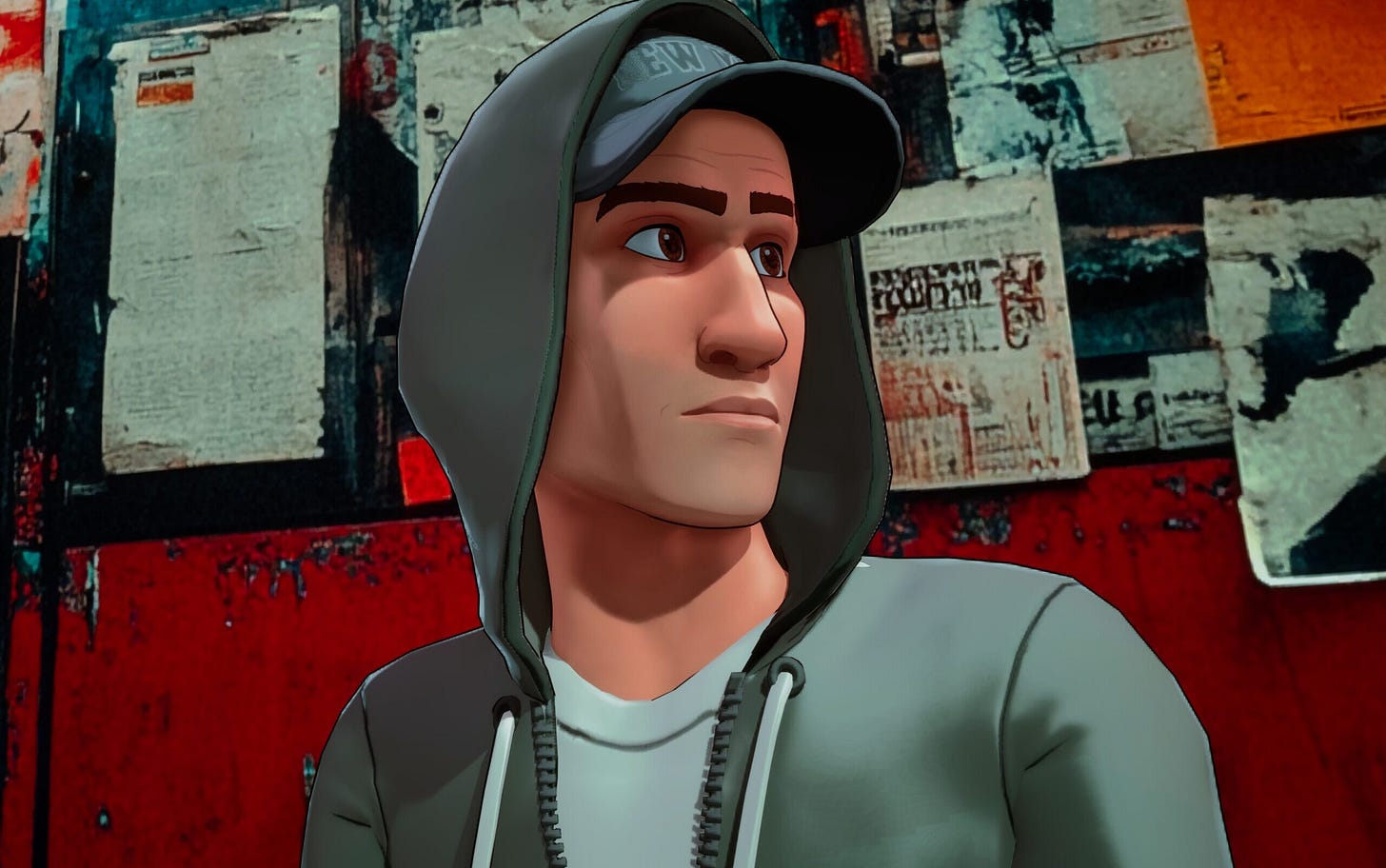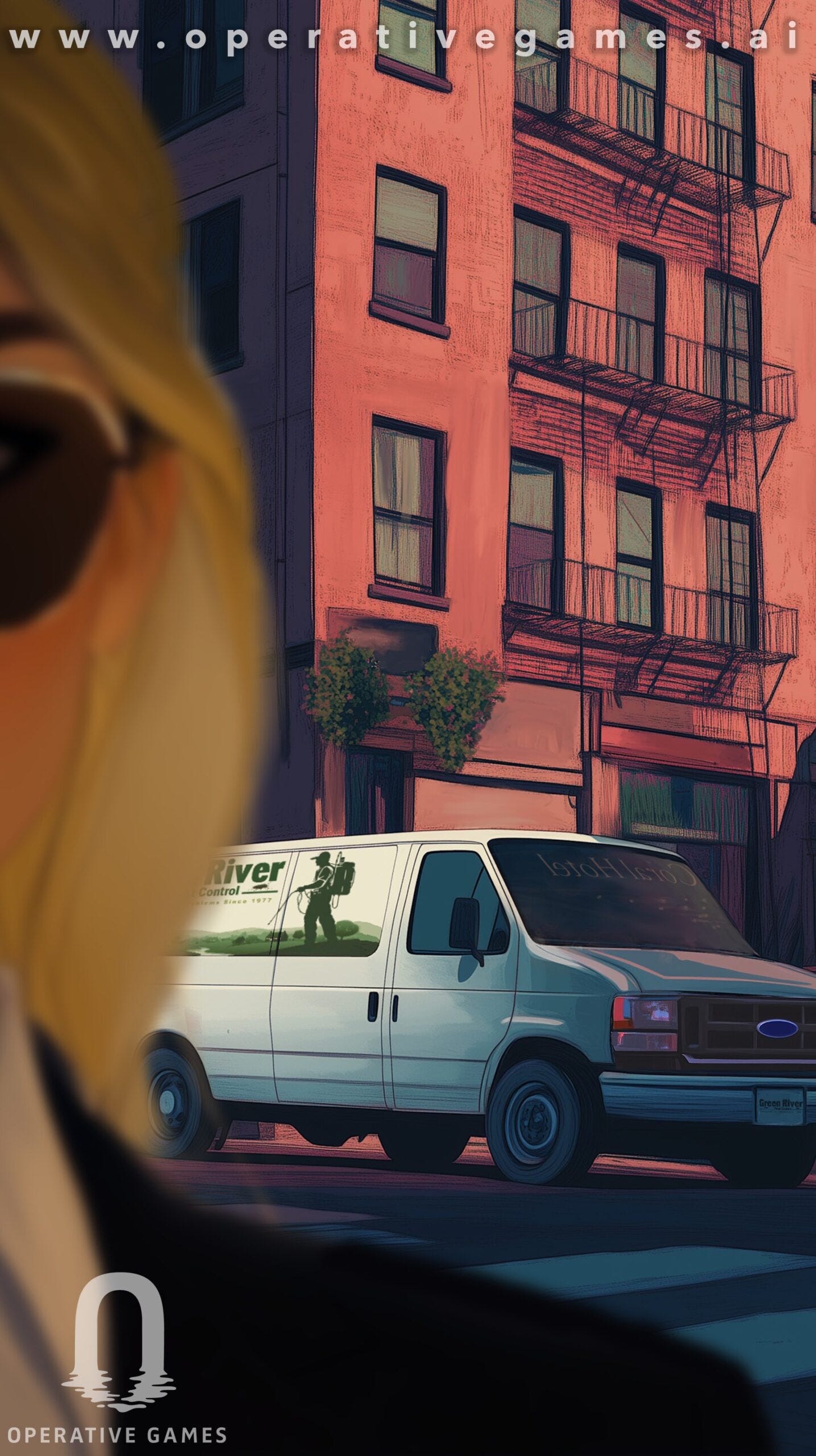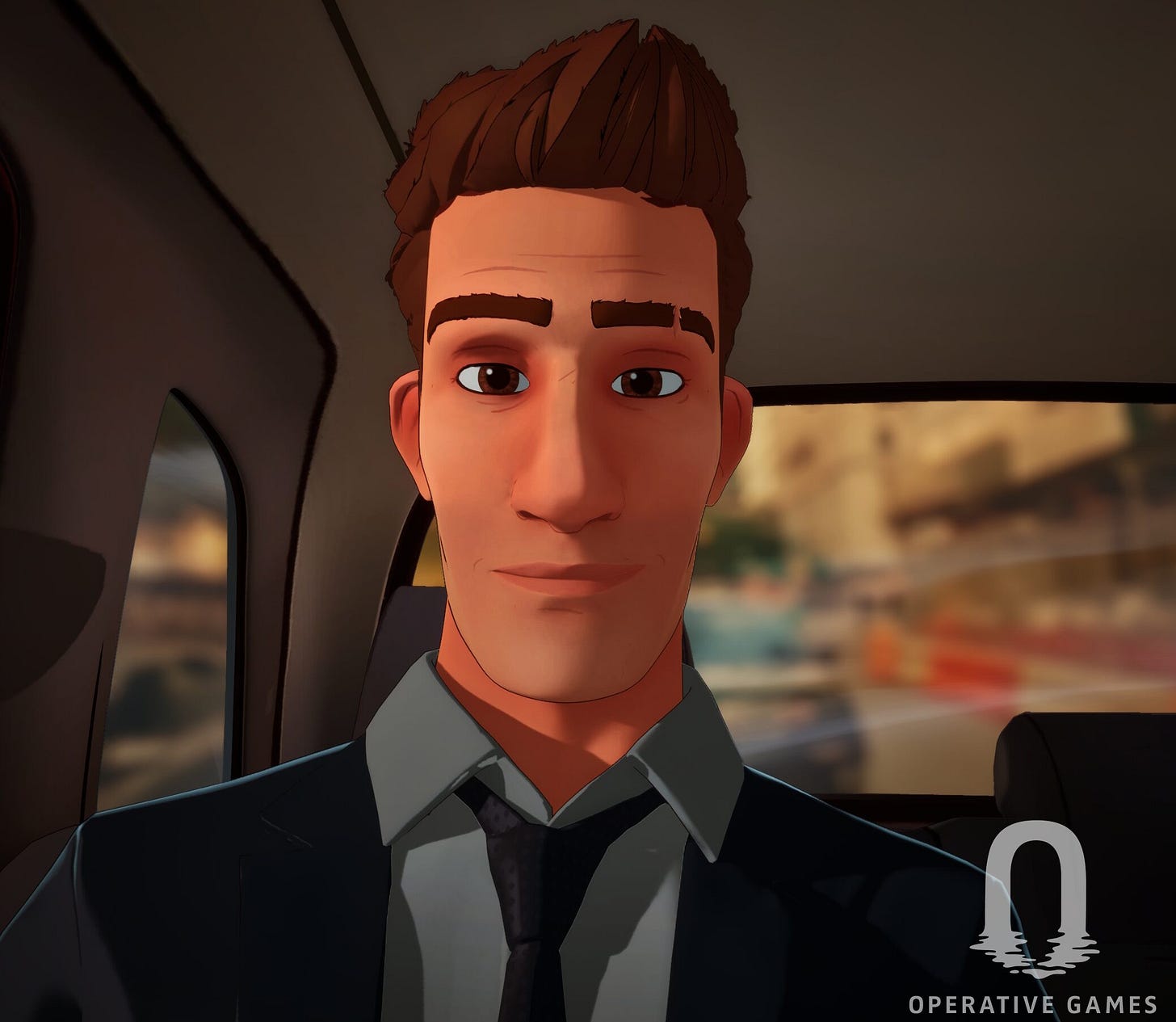"This is about creating characters that feel as real as possible"
Jon Snoddy and Jon Kraft on creating Hollywood-style stories with AI characters you can even call on the phone.
Hello and welcome back to AI Gamechangers, your weekly insider's guide to practical applications of artificial intelligence in the games industry. We’re speaking with people across the whole ecosystem, from game designers to UA experts, from audio experts to app store bosses, building a picture of how AI is shaping the hopes and expectations of the games industry.
This week, we're diving into the fascinating world of AI-powered interactive storytelling with Operative Games. It’s a new venture that combines Hollywood screenwriting talent with the latest AI models to create emotionally resonant characters. Players connect with them by phone, Zoom calls and other methods to create the sense that they’re participating in a real high-stakes adventure.
Scroll to the end for a healthy roundup of AI news, tools, and interesting links from the last week. And, as always, our archive of previous interviews is available for free browsing. Qapla'!
Jon Snoddy and Jon Kraft, Operative Games

Meet Jon Snoddy and Jon Kraft, the co-founders of Operative Games. The pair are entertainment industry veterans with an impressive pedigree. Amongst other roles, Snoddy previously led Disney’s R&D, while Kraft was the founding CEO of Pandora. The duo first collaborated to create avatar technology before reuniting to launch Operative Games in 2023.
This new venture uses AI-powered characters crafted by expert screenwriters to deliver emotionally resonant storylines. It uses a proprietary Story Engine with real-time animation and communication driven by LLMs. Its aim? To create a new genre of interactive entertainment that extends beyond the screen and places you at the heart of a mystery that evolves over several seasons.
Top takeaways from this conversation:
Operative Games is creating interactive entertainment where fully fleshed-out AI characters lead the player through episodic storylines that feel like high-quality TV narratives.
Interactions extend beyond the screen to phone calls with characters, creating a transmedia experience where players might "hire" specialist characters who remain available even after episodes conclude, creating a persistent story world.
Their approach flips traditional screenwriting on its head. Rather than dialogue and stage directions, writers create detailed character backgrounds, motivations, and histories that inform the AI's real-time generation of conversations.
The Story Engine tech monitors player interactions, gauging confusion, puzzle-solving ability, and pace preferences to dynamically adjust the experience, ensuring players feel successful and engaged.
AI Gamechangers: Please tell us about Operative Games. How did you come together?
Jon Snoddy: I spent roughly the last 15 years running research and development for Disney. Ran it for the whole company and then for the engineering group.
Disney's all about storytelling. When you're there, it's hard not to think of the world in terms of stories. I spent a lot of time working with the features team and different parts of the company that are really all about storytelling. In doing that, you get a real feel for how those characters come together.
There's a lot more than just writing a script and sending it down to animation. It's this real birthing process. It's a long process, and the result is that these characters connect with people deeply. It surprises even the company internally, the level to which people just connect with those characters.
So when you're watching that, and you're somebody like me, it's not a big leap to say, “Wow. Wouldn't it be amazing if you could take characters, crafted with that level of care and love and skill, and put them into a world with a scenario, and jump in there, and hang around with them?” That would be kind of cool!

This company is really that idea. It's about saying, can we create characters at that level of emotional fidelity? Like when you're watching a film, and it's a cartoon character, Buzz Lightyear; he’s on the screen when he's in trouble, you don't feel cartoon emotions. You feel very real emotions. And it’s crazy that artists can somehow do that. They can somehow encode humanity into these characters so that when they're in peril, you feel that, and when they're happy, you celebrate with them.
Large language models were starting to work, and early on at Disney, we really saw the promise of that. I realised it was time to go do something. So we started talking to people and thinking about it, and thinking about what kind of product would come out of this, and after several months of exploration, it gelled. And that's what we're building. So we went out and raised VC funding, and we're building our first game in production. We're talking with publishers while we're here at GDC, and it's something that we expect to launch toward the end of this calendar year.
How did you two first get to know each other?
Jon Snoddy: I worked at Disney a long time ago, then did some startups. Jon and I did a startup together called Big Stage Entertainment, where we took technology from the University of Southern California to create instant avatars (back when that was really hard). We created these photo-real avatars that would put you into advertising and games.
We did that company together, and then when we exited that I went off back to Disney, went to work for R&D...
Jon Kraft: At that point, I left and joined Bill Gross at Idealab. Bill and I started a company called Ubermedia.
But Jon and I stayed in touch. We started having regular calls about this vision. When we did our first company, which is some 17 years ago, this vision was very much front and centre – we talked about it all the time. We were creating avatars. We talked about bringing them to life!
“This is going to make story and character a deeper part of the gameplay and a more fundamental part of the experience than it is right now”
Jon Kraft
And then, five years ago, we felt the time was coming. Twice a week, we had brainstorming sessions, and then, about two years ago, there was an inflection point with large language models. Jon called me and said, “This is the moment. It has to happen now.”
Jon Snoddy: It's worth knowing that Jon also was the founding CEO of Pandora. He has a great past!
It’s great that you’re using AI to create new experiences rather than just streamlining existing processes. Can you talk us through what happens when a player starts interacting with your characters?
Jon Snoddy: The reason we would go to the trouble of starting a company is because there was something new that could be done suddenly. And it wasn't like just taking things you've done 100 times and doing them again in blue rather than green. What this is about is creating characters that are like real people – we want them to feel as real and complete as possible.
We work with Hollywood screenwriters, great writers who have established a history of delivering massive audiences with the content they've created. And we have them create a scenario, story and then character descriptions, deep character descriptions (not just "he's 24 years old and male!"). It's history and hopes and fears and dreams, so that you get that full 360-degree picture of who this character is.
We want everything the character says to come from inside, from something good or bad that moulded them. So when you dial up one of our characters on the phone, you're talking to somebody that hopefully feels complete and as you get into the story that's more and more true.
So you get into the story, and you start to talk to these characters. You hopefully kind of become “friends” with them. And as you do, you discover that they’re just like you… except they're living this slightly larger life. And that gets them into a little trouble every now and then! And as they get into this trouble, they draw you in, and here you are, suddenly helping them in crazier and crazier situations.
“We use real humans to make the voices – and we pay them. We use real writers to create the scenarios. If we make money, they make money”
Jon Snoddy
The Operative, the first thing we're shipping, is kind of a spy story. It doesn't start out that way, but then you discover something bad is going on here, and it just gets bigger and bigger and bigger.
We called one of the characters and chatted with her. Wow. What’s behind it all? Can you reveal more about that Story Engine, your proprietary technology?
Jon Snoddy: Well, there's a whole family of technologies inside that umbrella Story Engine. This is a kind of a crazy time to be building technology, because everything changes every week! And there's always another announcement of something which is even better. And so we wanted to make sure we were riding on top of these 100-billion-dollar investments that other companies are making.
We are about taking those great LLMs and combining them with a story and giving a writer tools that allow them to create characters and then talk with them. There's this amazing moment, the first time we were able to do this. I handed a phone number to our head writer, who's written TV shows (and everything else – he's been around the block). I said, "Call this number!" And now he's calling a character that he wrote and talking to him on the phone.
The Story Engine allows him to do that kind of input, and it turns into this interactive experience. And then at run-time, the Story Engine monitors your interaction with the character. We can tell if you're confused or not, if you want to go faster, if you're really good at solving puzzles, if you're really bad at solving puzzles, or show no interest in those things. Then we can modify the way we present things to you so that hopefully you feel smart and successful and you have fun.
How do you make sure it doesn't go off the rails and start telling a different story?
Jon Snoddy: Yes, that's a significant thing. One of the things we do is we have another LLM that's looking at the conversation. Imagine if you and someone were having a conversation, and someone else is sitting in – your PR agent is sitting next to you, listening, maybe going, “We're not talking about that!”
I think there will be successful, open-world games based on AI. They will be great, lots of fun, no problem. We're doing something different, though. We're preparing some magical, crazy things! We're going to let you feel like you're going wherever you want to go. But we're quietly, gently using the characters to lead you.

The next thing you’ll do is going to be obvious because we've made it feel obvious. We'll lead you to the next piece of information and the next piece of information. Often, you're going to have to go get that information yourself. You'll solve a puzzle to get that information. You're going to earn that information and feel very proud that you were able to figure that out. But it's all leading you to an “Oh!” moment. That might be, “Oh no!” a terrible moment, or, “Oh wow!” a wonderful moment.
The game breaks away from the computer and includes unique interactions, including phone calls. So, how do I know when I'm done? How long does the game last?
Jon Snoddy: We think of these game chapters as episodes, and they're in a season. There might be eight to 12 episodes in a season.
You'll sign up, you'll pay a subscription fee and sign up for eight to 12 episodes, and each one will have a resolution. It'll have an ending. It'll feel like, “Oh man, we narrowly escaped that time!” And then… “Wait, it's even worse!” Because right behind the thing you just solved is another problem that you created earlier. We will take you through this 12-episode adventure that ends with a big ending, but then there's a tease for what's coming next, and then there will be another season and another season. We'll go on with this particular title as long as there's interest.
Jon Kraft: There are a number of characters in any of these episodes; some of them are part of the main thread of the story, and some are people that maybe you've had to hire. This is a world you're in where sometimes you need help, and you have to hire an expert, or a specialist in Eastern European culture and language, and so you've hired assistants.
“We were creating avatars. We talked about bringing them to life! And then, five years ago, we felt the time was coming. There was an inflection point with large language models”
Jon Kraft
They've helped you get through some tough moments, and when the story is over, those people still exist! You could still reach out and speak to them whenever you want. You know you've hired them – it costs money, but our thinking is there will be some characters we'll continue to make available after the story. It'll be strategic. Sometimes, you won't be able to reach certain characters after an episode ends, and they won't be available until shortly before the next season begins, but that's something under our control. Those are things that are special about this kind of title, this genre.
Which particular AI technologies are you using under the hood? Are you leveraging OpenAI, for instance?
Jon Snoddy: We use different things for different parts of the system. The Story Engine is portable. We mentioned how crazy it is to develop technology in a time when every minute there's another new thing, a DeepSeek appearing next week? We made a point of making sure that we’re easily separable from any LLM. We work right now with OpenAI, but we also work with other LLMs as well; there are several that are part of a whole ecosystem that we support. In some cases, we're training our own, and it’ll be an ever-changing ecosystem.
Your backgrounds are in the entertainment industries. How does creating characters and storylines for an interactive experience like this differ from TV or film or audio or other kinds of media?
Jon Snoddy: It's fascinating, actually, when you think about what a writer does [for TV]. A writer thinks about a story: they come up with an idea, they come up with a character. They start sketching out that character, thinking about where they came from, and some things about them. They start laying out storylines. There's all this detail: "I think he grew up in New Jersey, and his father was drunk, and his mother..." and they create all the stuff around it that informs the script. But they hand in dialogue and some stage notes, and then they're done! All that other stuff they made kind of just goes away.
Here, it's flipped. We don't need the dialogue. (They do some dialogue because we want to get the tone of the character's voice and everything, but the game dialogue is generated live.) So all that stuff that they used to throw away is the very stuff that they turn in now, which is kind of hilarious.
Jon Kraft: It flips it all upside down, but the actual work is very much the same. The actual work that they do is almost identical. It's just they turn in something different for us than what they turn in for ABC, right?
Jon Snoddy: An anecdote. When we started, the first conversations we had were right in the middle of the writers’ strike. You'll remember that AI was a big complaint in that. The guy who's our lead writer was literally walking a picket line while we were figuring out this company.
When we started saying to these people, “Can we talk about AI?” – some were hesitant. But in fact, when we started talking, we're asking them to do exactly what they do. They're the best in the world at this: characters and story and encoding humanity into words in a way that speaks to our hearts. It feels emotionally real to us.

And so we've had great responses from writers. Surprisingly, they're excited. They approached us thinking, “What do I know about this? I don't know anything about this stuff.” And then they get in and go, “Oh, wait. This is what I do!”
By the way, we use real humans to make the voices – and we pay them. We use real writers to create the scenarios. If we make money, they make money.
The first story you've got here is The Operative, a new story. The company press release hinted at partnerships with existing IPs down the line. Are you able to talk about any of your future plans in that regard?
Jon Snoddy: I've done a lot of R&D – that's sort of all of my career has been. And when you're doing that, you go into it with an idea of where you're going to end up, but it wouldn't be R&D if you knew exactly where! So when you go to someone and say, “I'd like to take your most valuable IP and experiment with it”, they can't do that. It's just too valuable. You need the room to be able to create.
So we knew we'd have to create our own IP. Even when I was at Disney, we would create our own IP because the company's IP often, for very early explorations, was just too valuable to misuse.
But down the road, now that we know what it is, we are in talks with all of the usual suspects. They're pretty excited about what this could mean for their IP.
After your first call with a character, you start to see the potential. Is the system you've built with The Operative adaptable to other worlds and types of stories beyond spy narratives?
Jon Snoddy: The system’s adaptable to many other jobs, and there are layers to this. We have this core that creates the AI character, and that's a core piece of the Story Engine, and that can plug into any type of place you need a character, even a character that's the front end to your city search kind of thing, or anything like that. That can plug into this engine, and when you talk to it, it will stay in character. It will stay in the story. It knows who it is. It knows who it is not, and it knows the things it can talk about and things it cannot talk about. And so that's kind of just a module there, and that can be used in any type of story.
Jon Kraft: What you don't necessarily want to do is to take an existing genre game and introduce interesting characters that players want to stop and talk to, even if it's infused with some story because then it distracts from the actual game itself.
“We want everything the character says to come from inside. When you dial up one of our characters on the phone, you're talking to somebody that feels complete. You hopefully become ‘friends’ with them”
Jon Snoddy
So this is going to fit really nicely into all kinds of different genres. It's going to change the way people write those genres, and it's going to make story and character a deeper part of the gameplay and a more fundamental part of the experience than it is right now.
Right now, if you just took an existing major title and infused it with our technology and our characters, it really begs a rethinking of that existing title. I think it will fit into other genres, but they also have to be rethought to incorporate this kind of approach.
Do you imagine that this is a whole new medium of storytelling? Perhaps we might see more of this sort of thing in future?
Jon Snoddy: I think so. It will go in many directions. We’re showing the world something, and five years from now, we'll look back, and it'll just seem completely obvious.
Further down the rabbit hole
What’s been happening in AI and games? Here’s your essential news round-up:
Speaking at New Game Plus during the London Games Festival, the CEO/CTO of AI Guys, Ken Noland, demonstrated how he recreated the original X-COM game from scratch in three months (although overall, he concludes AI tools don’t yet live up to the hype).
AI startup Runway says its new Gen-4 video model is consistent across multiple scenes, including generating people.
Every platform wants to be a games publisher these days. That includes Tinder, apparently, which has added an AI game to its app. It challenges you to be better at flirting.
The experts behind Aarda AI have played new AI-powered Sims-alike InZoi. Their conclusion? It represents a promising step rather than a definitive breakthrough in AI-driven entertainment.
The Switch 2 dominated the games news cycle this week. It’s worth noting that while Nintendo itself has long said it won’t use AI in the creation of first-party games, NVIDIA's AI technology plays a significant role in the Nintendo Switch 2's hardware capabilities.
Midjourney releases version 7, its first major release in nearly a year.
WishRoll presented its runaway success Status alongside Inworld at GDC. The game is a social media simulator where you are the main character. You can read the full Q&A with CEO Fai Nur in a future edition of AI Gamechangers.
And speaking of future interviews, we’ll also catch up with Anna Zdorenko, CEO of INCYMO.ai, soon. The company launched its AI-powered creative platform for crafting mobile games ads last week.
CEO of Take-Two, Strauss Zelnick, publisher of Grand Theft Auto, is pretty sure AI isn’t the future of game development: “I’m not worried about AI creating hits, because it’s built on data that already exists. It’s backward-looking. Big hits are forward-looking and therefore need to be created out of thin air.”
Anuttacon, a new independent studio, just unveiled Whispers from the Star. It’s an AI-enhanced narrative game that reimagines interactive storytelling through open-ended dialogue. The sci-fi adventure features protagonist Stella, a stranded astrophysics student who players must guide.


